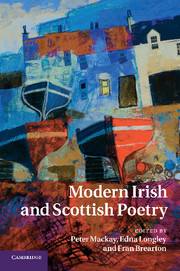Book contents
- Frontmatter
- Contents
- List of contributors
- Acknowledgements
- Introduction
- 1 Swordsmen: W. B. Yeats and Hugh MacDiarmid
- 2 Tradition and the individual editor: Professor Grierson, modernism and national poetics
- 3 Louis MacNeice among the islands
- 4 Townland, desert, cave: Irish and Scottish Second World War poetry
- 5 Affinities in time and space: reading the Gaelic poetry of Ireland and Scotland
- 6 Contemporary affinities
- 7 The Classics in modern Scottish and Irish poetry
- 8 Translating Beowulf: Edwin Morgan and Seamus Heaney
- 9 Reading in the gutters
- 10 ‘What matters is the yeast’: ‘foreignising’ Gaelic poetry
- 11 Outside English: Irish and Scottish poets in the East
- 12 Names for nameless things: the poetics of place names
- 13 Desire lines: mapping the city in contemporary Belfast and Glasgow poetry
- 14 ‘The ugly burds without wings’?: reactions to tradition since the 1960s
- 15 ‘And cannot say / and cannot say’: Richard Price, Randolph Healy and the dialogue of the deaf
- 16 On ‘The Friendship of Young Poets’: Douglas Dunn, Michael Longley and Derek Mahon
- 17 ‘No misprints in this work’: the poetic ‘translations’ of Medbh McGuckian and Frank Kuppner
- 18 Phoenix or dead crow? Irish and Scottish poetry magazines, 1945–2000
- 19 Outwith the Pale: Irish–Scottish studies as an act of translation
- Guide to further reading
- Index
- References
4 - Townland, desert, cave: Irish and Scottish Second World War poetry
Published online by Cambridge University Press: 18 April 2011
- Frontmatter
- Contents
- List of contributors
- Acknowledgements
- Introduction
- 1 Swordsmen: W. B. Yeats and Hugh MacDiarmid
- 2 Tradition and the individual editor: Professor Grierson, modernism and national poetics
- 3 Louis MacNeice among the islands
- 4 Townland, desert, cave: Irish and Scottish Second World War poetry
- 5 Affinities in time and space: reading the Gaelic poetry of Ireland and Scotland
- 6 Contemporary affinities
- 7 The Classics in modern Scottish and Irish poetry
- 8 Translating Beowulf: Edwin Morgan and Seamus Heaney
- 9 Reading in the gutters
- 10 ‘What matters is the yeast’: ‘foreignising’ Gaelic poetry
- 11 Outside English: Irish and Scottish poets in the East
- 12 Names for nameless things: the poetics of place names
- 13 Desire lines: mapping the city in contemporary Belfast and Glasgow poetry
- 14 ‘The ugly burds without wings’?: reactions to tradition since the 1960s
- 15 ‘And cannot say / and cannot say’: Richard Price, Randolph Healy and the dialogue of the deaf
- 16 On ‘The Friendship of Young Poets’: Douglas Dunn, Michael Longley and Derek Mahon
- 17 ‘No misprints in this work’: the poetic ‘translations’ of Medbh McGuckian and Frank Kuppner
- 18 Phoenix or dead crow? Irish and Scottish poetry magazines, 1945–2000
- 19 Outwith the Pale: Irish–Scottish studies as an act of translation
- Guide to further reading
- Index
- References
Summary
When C. Day Lewis asked ‘Where are the War Poets?’ he not only opened a debate surrounding the role and perceived absence of poetry of the Second World War but also revealed a concern with location – and in particular the relationship between place and politics, or between geography and history – which would characterise much Second World War poetry. The status and role of ‘war poetry’ are problematic for Day Lewis: in an act of moral abnegation he suggests that the obligation he and other poets felt to defend ‘the bad against the worse’ was ‘No subject for immortal verse’. Day Lewis's moral dilemma is what role, if any, poets and poetry should play in the war; his own answer is that poetry should have no role in a war so ideologically dubious.
This dilemma comes into sharp focus when distinctions within national contexts – Irish neutrality, the absence of conscription in Northern Ireland, Scottish Nationalist conscientious objection – are taken into account; when, instead of defending ‘the bad against the worse’, there was the possibility of letting the bad and worse decide their fates among themselves. The emphasis on location (and subsequently on perspective) in Day Lewis's dilemma is important because there are quite different roles for poetry from three different locations for war poetry (and these are only three possible locations for this poetry): the African desert, where many poets (including many Scottish poets) served with the 51st Highland Division; ‘Plato's cave’ […]
- Type
- Chapter
- Information
- Modern Irish and Scottish Poetry , pp. 87 - 101Publisher: Cambridge University PressPrint publication year: 2011

